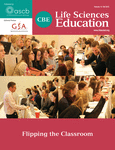Response to Overcoming the Barrier to Implementing Authentic Research Experiences through Faculty Mentorship: The ASCB Mentoring in Active Learning and Teaching (MALT) Program Is Designed to Facilitate Vision and Change–Inspired Teaching Practices
To the Editor:
In their recent letter to the editor, Goedhart and McLaughlin (2015) suggested mentorship as a solution to helping individuals effectively implement inquiry-based learning as described in the Vision and Change report (American Association for the Advancement of Science, 2011). While several initiatives have risen to the challenges of implementing the goals of Vision and Change across undergraduate life sciences education, they have often been limited by their short-term nature in the form of one-time workshops and institutes. Oftentimes, while attending these workshops, instructors are excited about meeting the Vision and Change goals, only to return home and run into barriers. Instructors experiencing these challenges would benefit from expert feedback and ongoing discussions about the theoretical underpinnings of active learning (D’Avanzo, 2013). These types of discussions could be supported by the more extensive mentorships suggested by Goedhart and McLaughlin, leading to sustainable change in the science, technology, engineering, and mathematics (STEM) community with respect to how undergraduate science is taught.
In line with promoting long-term teaching mentorship, the members of the American Society for Cell Biology (ASCB) Education Committee initiated the Mentoring in Active Learning and Teaching (MALT) program (http://ascb.org/mentoring-in-active-learning-and-teaching-malt). The program encourages long-term mentoring relationships to facilitate the implementation of evidence-based active-learning strategies. Mentors are recruited through the ASCB website and are required to provide evidence of their commitment to active learning. A mentee applying to the program can already have a designated mentor or can ask to be paired with a mentor. Through the current version of the program, 25 partnerships have been formed. Most mentors have been paired with mentees in close proximity to facilitate in-person meetings, but several long-distance partnerships have been maintained through Skype and phone calls. In some cases, the mentorship has involved providing career advice about how the mentee can acquire more teaching experience. In other cases, the mentor worked with the mentee on the development of a specific curriculum that the mentee then implemented at the mentee’s home institution or in the mentor’s classroom. In one case, a pairing resulted in a postdoctoral fellow incorporating his cutting-edge research from the National Institutes of Health into the mentor’s classroom at a primarily undergraduate institution. There is funding to facilitate mentee travel, with an expectation that the mentee will establish learning outcomes and that a video of the mentee teaching is submitted for Classroom Observation Protocol for Undergraduate STEM scoring (Smith et al., 2013) to confirm that the mentee is adopting active-learning techniques.
We encourage the LSE readership to consider signing up to serve as mentors in the program or to refer mentees to the program. There is already support and engagement from members of the Genetics Society of America and the American Society of Plant Biologists to extend the MALT program, and we welcome members of other professional societies to join in our efforts.
Another idea raised in Goedhart and McLaughlin’s letter is the importance of society meetings in building mentoring relationships. The ASCB Education Committee is interested in facilitating the formation of regional groups that would meet to share strategies and work together on implementing new initiatives for teaching in line with Vision and Change principles. We encourage ASCB members to consider attending a gathering at the upcoming annual meeting in San Diego to explore this possibility. We anticipate that by creating instructor-learning communities committed to teaching students with active learning, the MALT program will build individual instructors’ competence and support a shift in the undergraduate biology paradigm.
ACKNOWLEDGMENTS
Pilot funding for the MALT program was provided by the American Society for Cell Biology.



